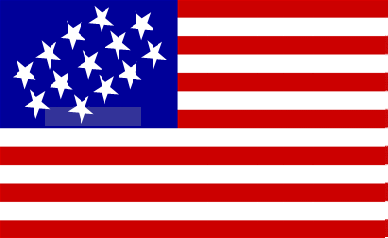
13-Star Flag
|
The Ft. Harmar Flag 1786
The Congress, created by the Articles of Confederation, ordered Fort Harmar built in 1784. Colonel Josiah Harmar was dispatched to the Ohio frontier with orders to discourage illegal settlers from moving into Ohio. In 1785, Harmar ordered the construction of Fort Harmar at the junction of the Ohio River and the Muskingum River, near near present day Marietta. During construction a crude drawing was made of the walls, probably by workmen, which showed this flag. It is of interest because the five-pointed stars, placed in a 4-5-4 pattern, were placed in a 45º diagonal angle.
Strangely enough, rather than discouraging squatters, the fort encouraged settlement because the settlers believed Harmar's troops would protect them from Native American attacks. In 1789, the Treaty of Fort Harmar, was sign between the United States and the Six Nation federation (Wyandot, Delaware, Ottawa, Chippewa, Potawatomi and Sauk) who met with Northwest Territory Governor Arthur St. Clair at Fort Harmar. Unfortunately, the new treaty didn't stop the violence which continued for another six years, until the Battle of Fallen Timbers. The Treaty of Greenville (1795) forced the tribes to give up most of what is now the state of Ohio. |
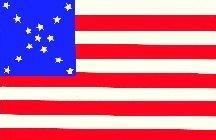
14-Star US Flag
|
The Nathan Beman Flag 1791
This rare flag is one of only a very few known United States flags displaying 14 stars, representing Vermont’s admission as the 14th state in 1791. This flag only had 10 stripes and appears to have been a parade and rally flag that was originally given as a gift to Nathan Beman, one of Ethan Allen’s "Green Mountain Boys," at some time between 1795 and 1815. Nathan Beman assisted Ethan Allen during the surprise attack and capture of Fort Ticonderoga. It was the capture of its cannons and the eventual delivery to Dorchester Heights in Boston that allowed Washington to beat the British and win Boston in the early days of the Revolution.
|
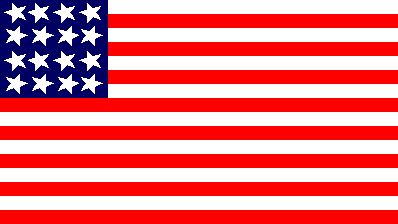
16-Star US Flag
|
The Unofficial 16-Star US Flag 1796
Although the star pattern used in the canton of this Stars and Striped flag has been arranged in normal horizontal lines, it is shown here because this is an example of an unofficial variant of a flag that never existed! In 1795, the United States flag law had changed to have the flag go from 13 stars and stripes to 15 stars and stripes, however, no provision was made for recognizing the entry of new States into the union, or a standard process of how to change the flag design when this happened. Therefore, in 1796, when Tennessee entered as the 16th State, the flag wasn't changed as Congress discussed the problem.
Many times flag makers simply ignored the fact that a stars and stripped flag using a certain number of stars must be made official by the Congress of the United States by resolution, and simply made new flags before the fact. After the 15 stars resolution, there was no "approved" change in the flag until 20 states were made in 1818. Hence, "officially" this flag didn't exist. |
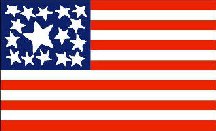
17-Star US Flag
|
The Colrain School House Flag 1812
In 1812, a 17-star US Flag was first raised over a school house on Catamount Hill in Colrain, Massachusetts. It wasn't until after the Civil War that flying the flag at schools and other public buildings became a general practice. Flying this hand-made 16-star flag was, as far as we know, the first known instance of a flag being flown at a school house, and predates the Civil War by almost 50 years.
This may be yet another flag first for the State of Massachusetts to add to their impressive list of first. |
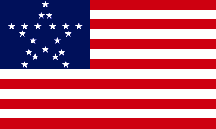
20-Star US Flag
|
The "Great Star" Flag 1818
Although, not an "official" flag design, this 20-star flag flew over the Capitol dome for six months in 1818. There have been many suggested "Great Star" designs like this one over the years. Flags whose stars form a larger star are called either "Great Star" flags or "Grand Luminary" flags. The terms are interchangeable.
The first of these Grand Luminary designs, proposed in 1818, that most people know about was the Peter Wendover/Samuel Reid proposal to have the U.S. Flag bear the stars in a "Great Star" pattern for use on land and on private ships, but to use rows for the navy. Congress did not accept this idea; in fact, Congress purposely did not specify how the stars were to be arranged at that time. |
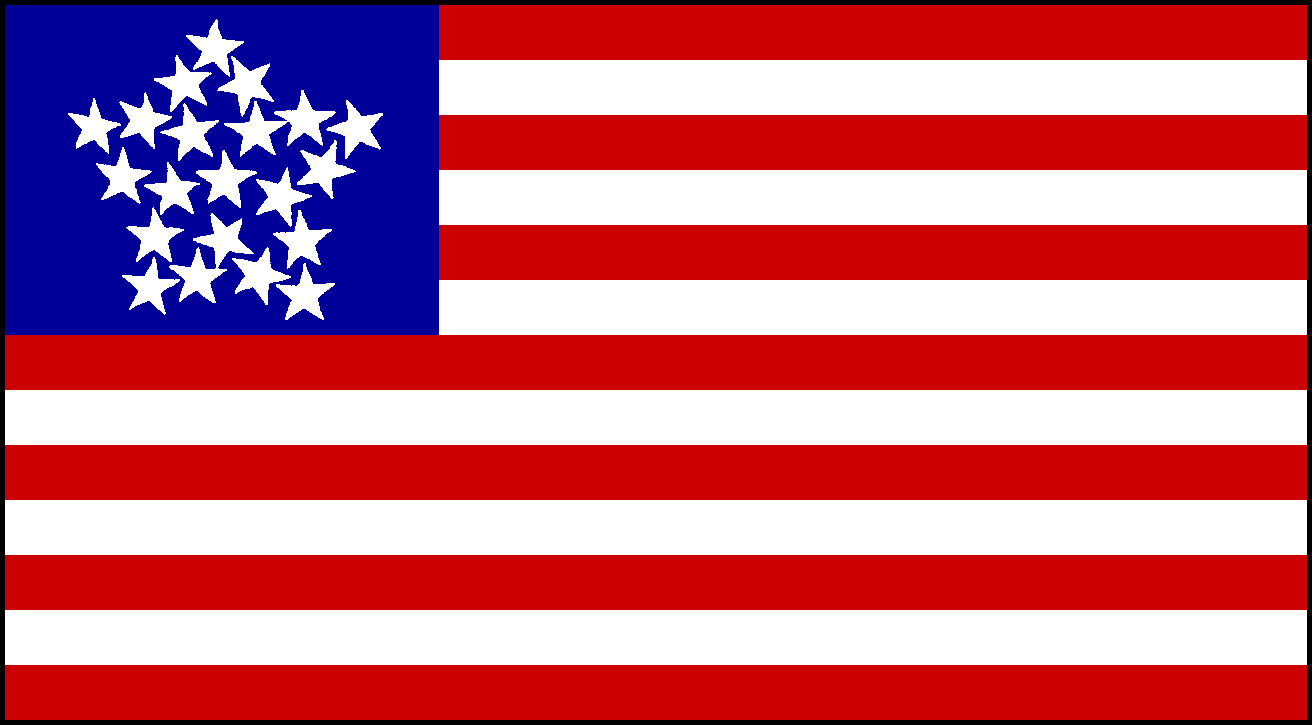
20-Star US Flag
|
Star Cluster Stars and Stripes 1818
Another "Grand Luminary" flag designs seen in 1818 was the Star Cluster design shown here where the Great star was custered tightly together.
|

17-Star US Flag
(1796)

25-Star Naval Ensign
(1836)
|
The "Star within a Circle of Stars" Designs
These designs, probably based on the traditional "Betsy Ross" and "Cowpens" designs of the Revolutionary War (disputed) all had common design eliments.
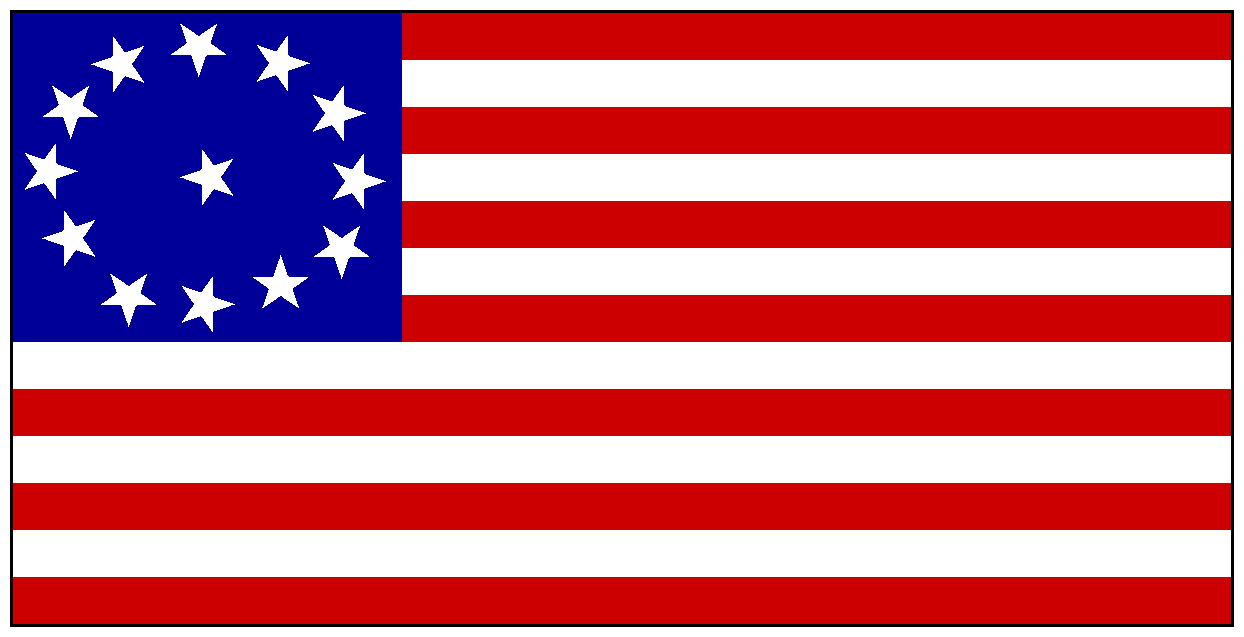 13-Star "North Point" Flag 1814 13-Star "North Point" Flag 1814
(Sometimes referred to as the "Cowpens" Flag)While the "official" standard for the flag was one stripe for each star until 1818, this un-official 1796 flag (top left) returned to the 13 stripes, still having 17 stars. There were 17 striped flags in use as well.
The practice of having one star centered in a circle of stars was well established by 1836, as demonstrated in the 25 Star Naval Ensign (bottom left), with the large center star normally representing the newest star admitted to the Union. The state represented on this flag would be Arkansas, the 25th state admitted to the United States. This particular flag was presumed to be a naval ensign. |
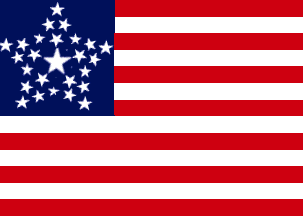
26-Star US Flag
(Type 1)
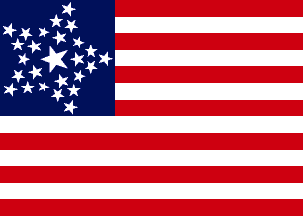
26-Star US Flag
(Type 2)
|
The Great Star or "Grand Luminary" Designs of 1837
There were several different "Great Star" design flags used between 1837-1845 that seemed to rotate the star's axis making it appear even upside down at times. This interesting "upside down" star-within-a-star-within-a-star effect is a fine example of early design variations. Akin to the "Circle within a circle" design, this one has a large star in the center, with five stars forming a star pattern around it and the remaining 20 stars forming a large star around them.
 26-Star US Flag (Type 3) The Great Star Design of 1837, was depicted in the US Flag Commemorative postage stamp set (1976), consists of 13 stripes, blue canton with 26 5-pointed stars arranged as in our Type 3 variant: with one very large star in center, 5 smaller stars in each angle of center star, 5 smaller stars between each of the previous 5, and 3 yet smaller stars at each ordinal point, giving impression of a large star pointing down. |

26-Star US Flag
|
The Gildersleeve Comet Flag 1837
This flag derives its name from the fact that the name "S. Gildersleeve" is written on its host. Sylvester Gildersleeve ran shipping company in Portland, Connecticut, and probably used this flag on one of his ships.
Although there are many theories as to what the star pattern represents, the most popular is that the star patten represented a comet rushing across the sky, hence the name "Gildersleeve Comet Flag." The actual design symbolism intended by the maker has been lost.
|
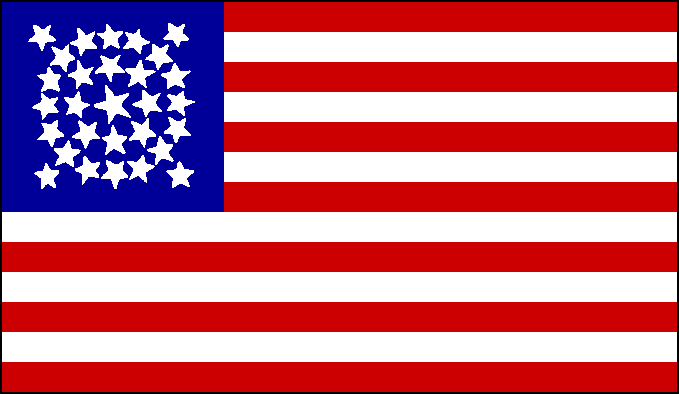
29-Star US Flag
|
Double Wreath Design 1847
This flag uses what is called a Double Wreath star pattern, which was popular in the 1840s. Techniques of printing on silk and cotton had been discovered that allowed campaign and small flags (sometimes called economy flags), could be produced and sold for a very low price. This made them a natural for political rallies and flag-waving campaigns.
This flag probably dates from the 1848 presidential elections, but the double wreath design would be used on various Mourning flags from 1840 through 1860. Black bunting would be added in many cases.
|
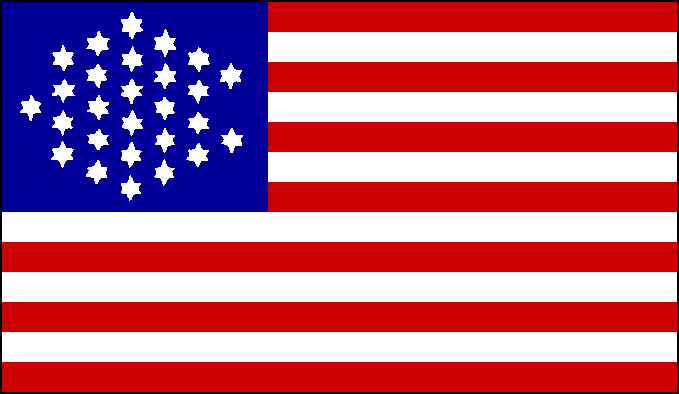
27-Star US Truncated
Diamond Pattern Flag
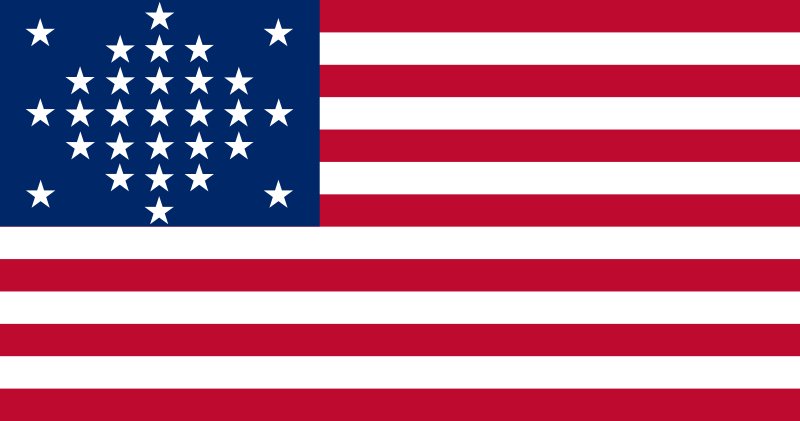
29-Star US
Diamond Pattern Flag
|
US Diamond Pattern Garrison Flags 1845-1867
Between 1845 and 1867, many Union forts used garrison flags utilizing a star arrangement known as the "Diamond pattern." It was a diamond pattern flag that flew over Fort Sumter in 1861 when the Civil War began.
|
|
|
33-Star Diamond Pattern |
|
37-Star Bunting Company Flag |
Many U.S. Army garrison flags were made by the US Bunting Company. Benjamin Butler, a US Civil War General and Congressman from Massachusetts, was an owner of the US Bunting Co. located in Lowell, Mass. After the Civil War ended, his company developed a patented method for resist-dyeing wool to make flags and Butler eventually got the US Congress to pass a law giving preference to US made bunting when buying flags for the government. Since his company was the only one making wool bunting in the United States, this was definitely an advantage for the company. His Company stayed in business up to the early 1890s.
|
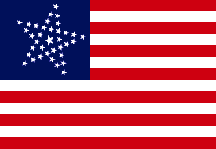
31-Star US Flag
|
The 31-Star Great Star Flag 1851
This "Grand Luminary" design was a very poplar one with the general public, but was not made official in 1851. The military never used this flag design, but it was popular with civilians.
In the case of this Grand Luminary, California was admitted into the Union in 1850, and according to the provisions in the Compromise of 1850, since California was a Free State (no slavery), another slave state had to be admitted to keep the balance, thus the 31-Star design. |
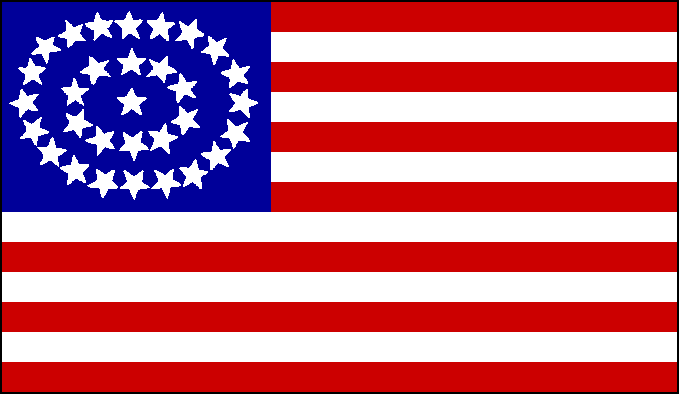
31-Star US Flag
|
Concentric Circle Design, or "Lincoln Campaign" Flag 1850
Another popular non-military 31-Star design is sometimes called the "Lincoln Campaign Flag." Abe Lincoln served as a United States Congressman between 1847 and 1849. He was, however, not reelected in 1848. He then campaigned again for his old seat in 1850, which is when this flag was used, from just after the admission of California, but before the official addition of their star to the flag, until the official one was approved. Lincoln lost this election and another in 1858 to Stephen Douglas, but was elected President in 1860.
The design has the stars arranged with one in the center and two concentric rings of stars and one in each corner. The pattern used here became popular during the Civil War until the late 1800s. |
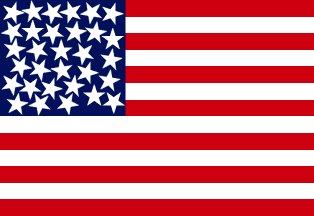
31-Star US Flag
|
Full Canton Design 1851
Another example of a tribute to our First Centennial shows in this attempt to plan the size of the stars so that they fill as much of the blue canton as possible. The result is almost a random looking star pattern with no clear horizontal rows.
(Personally, I always considered this a grownup version of the Colrain School House Flag of 1812, but I digress...) |
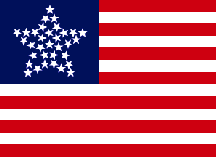
33-Star US Flag
|
The 33-Star Great Star Design 1859
Although never an official version of the United States flag, this very popular variant design was proudly displayed by many patriotic Americans. It was never officially used by the military or any government organization.
It should be noted here that Congress had never made any regulation about what type of star pattern should be used on the "official" United States flag. Therefore, any pattern was acceptable. The Navy regulated the star pattern on their "boat" flags to horizontal rows, but the Army and civil government did not. This explains the many different star patterns. |
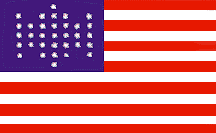
33-Star US Flag
|
The Fort Sumter Diamond Flag 1861
The 33-Star garrison flag that flew over Fort Sumter is sometimes called "the flag that started a war." The fort's commander was Major Anderson when the first shots of the American Civil War were fired in Charleston harbor. He surrendered to the Southern forces under General Beauregard after three days of token resistance. The only two casualties of the fighting were two Confederate privates killed when their cannon accidentally exploded.
Ever since the Mexican-American War (about 1845) the Army had followed an unofficial tradition of using a "diamond" pattern for the stars on their garrison flags. The Fort Sumter flag is a good example of this practice. |
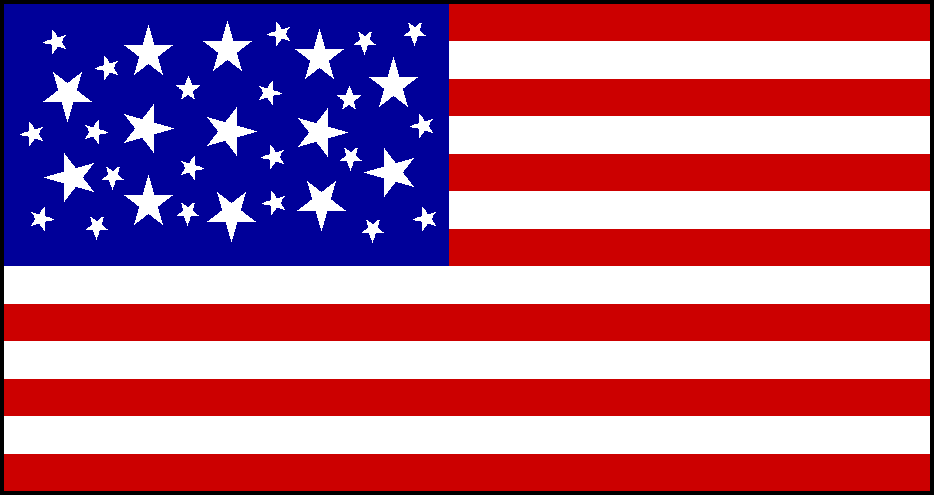
34-Star US Flag
|
Thirteen/Thirty-Four Flag 1861
The year 1861 saw many unusual and interesting flag designs marketed. This one attempted to honor the original and traditional 13 states by enlarging their stars among the scattered thirty-four states in the Union at that time.
|
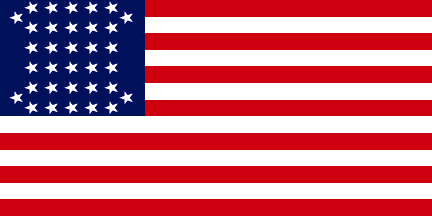
34-Star US Flag
|
Phalanx Design Flag 1861
The unusual length of the field of stripes indicates that this great standard was probably a naval flag. The pattern is basically a square "phalanx" of militarily aligned stars, with two independent "leaders" at left, and two "stragglers" at right. The result of this arrangement is a striking and very likely unique interpretation of the theme.
|
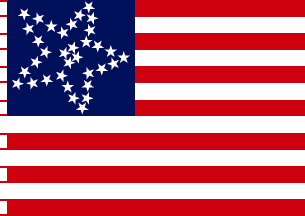
The 34-Star US Flag
|
The 34 Star Great Flower Design 1861
The "Great Flower"" flag, also known as "The Candy Stripe"" flag because of the red and white "candy stripe" running down the left side. Five asymmetric petal shapes loop out from the off-center heart of a graceful "Great Flower" pattern of thirty-four stars. The designer and locations that used this 1861-1863 flag are unknown.
|
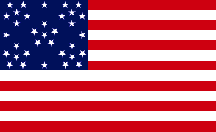
34-Star US Flag
|
The 34-Star Cluster Design 1861
This clever variant had five clusters of six stars each with the final four stars being centered on the top, sides and bottom. The five clusters of stars form a Saint Andrew's Cross and the four single stars form a Saint George's Cross. Because of this, this design was also called the "Great Cross" Flag. |

34-Star Round
|
New Jersey Regimental Flags 1861
These national presentation colors were manufactured by the Evans & Hassall Company of Philadelphia for all the Union New Jersey regiments after 1863.
This design is very reminiscent of the Concentric Circle Design Flag of 1851 and became a popular method of arranging the increasing number of stars as the nation grew. |
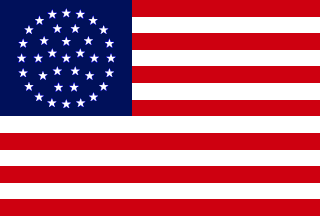
36-Star US Flag
|
36 Star Wagoon Wheel Design 1865
This "Wagon Wheel" design is another sample of a circle of stars with an inner design. A close look will reveal a circle of stars within the outer circle with a five-point "star cluster" in the middle. It was also a favorite naval pattern well into the 19th century.
|
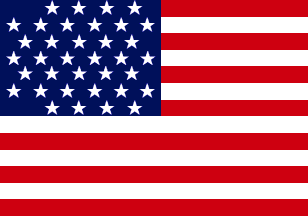
36-Star US Flag
|
36 Star Garrison 1865
This unusual, almost squarish flag, with a rather mixed 4-6-5-6-5-6-4 staggered pattern in the canton makes it a rather hard flag to label. Although this flag was not used widely, there are a few confirmed uses as a garrison flag during the Civil War.
A "Post Flag" is a large flag flown at military forts and posts. With a ratio of about 1:2, they measure about 8 feet by 17 feet. A "Garrison Flag" is larger and only flown usually on special days with measurements of 20 feet by 38 feet. |
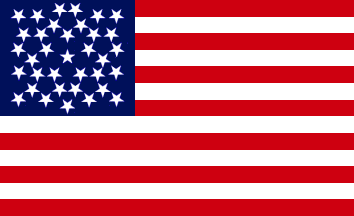
36-Star US Flag
|
The "Windblown" Stars Flag 1865
The "Windblown Flag" of thirty-six stars was once the possession of Civil War veteran, Louis Bernard, later a pioneer in Oregon. The canton's illusionistic design that appears to taper at one end, creates the impression that the flag is in motion - or "windblown" - even when at rest, as shown here.
This flag is especially interesting and fun because the human mind will spend time trying to find patterns and designs within the star pattern, enjoy the ride...
|
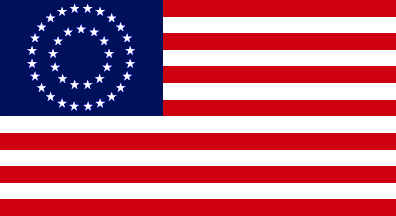
37-Star US Flag
|
The "Medallion" Centennial Flag 1867
The so-called "Medallion" Centennial Flag of 1867, would become one of many that were made to celebrate the upcoming First Centennial in 1876. With its "Betsy Ross" circle of 13 stars are in the inner ring to identify the original 13 colonies, and an outer circle of 24 stars to identify the states that have joined the union since that time, this flag was a natural choice for the event. |
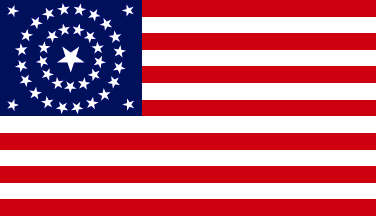
38-Star US Flags
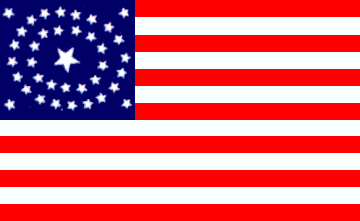
Oval as depicted on stamp
|
The Concentric Circle Designs of 1877
In 1877, one star was added to the United States flag, representing Colorado, bringing the total number of stars to 38. Several unofficial designs with concentric circles became popular, probably caused by the popular First Centennial designs used in the 1876 celebrations. Versions of the flag included both elongated and regular circle versions.
The flag with the elongated oval-shaped star design, was depicted on the 1976 commemorative postage stamp set, with 13 white and red stripes, blue canton with one larger white 5-pointed star in center, 13 white 5-pointed stars in oval around central star, 20 white 5-pointed stars in oval around that and one white 5-pointed star in each corner.
As previously mentioned, the pattern with the stars arranged with one in the center and two concentric rings of stars and one in each corner, had became extremely popular during the Civil War and remained so until the late 1800s. |
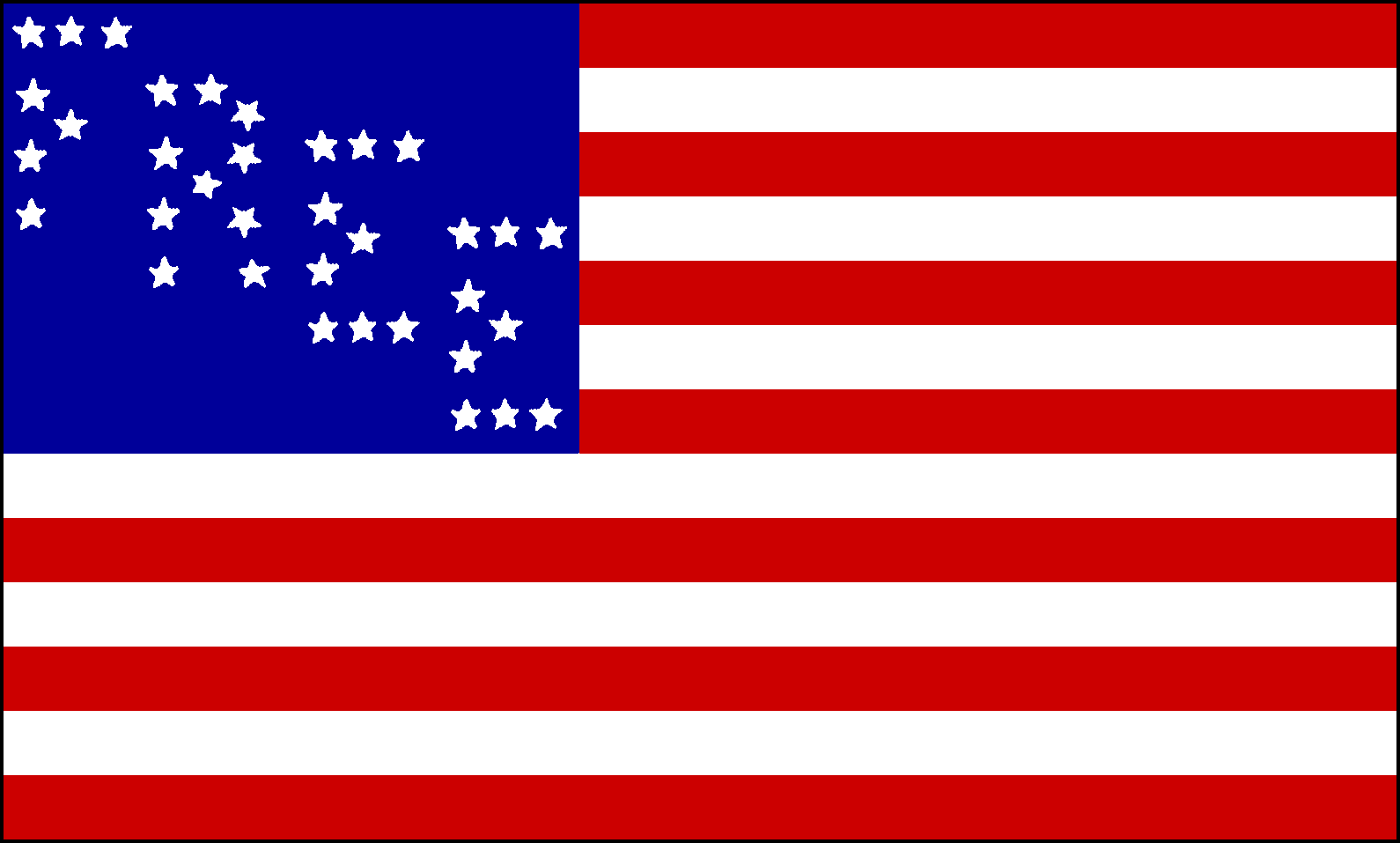
35-Star US Flag
|
Free Soiler Party Flag 1848
The 35 stars were arranged in this manner to spell "FREE" to declare support for the Free Soil Movement.
The Free Soil Party was a short-lived political party in the United States active in the 1848 and 1852 presidential elections, and in some state elections. It was a third party that largely appealed to and drew its greatest strength from New York State. The party leadership consisted of former anti-slavery members of the Whig Party and the Democratic Party. Its main purpose was opposing the expansion of slavery into the western territories, arguing that free men on free soil comprised a morally and economically superior system to slavery. They opposed slavery in the new territories and worked to remove existing laws that discriminated against freed blacks in states such as Ohio.
|
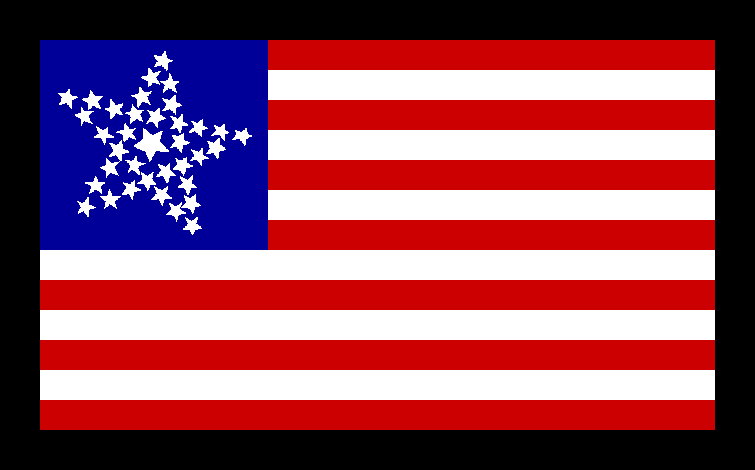
Grand Luminary Design
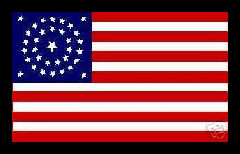
Two Concentric Circle Design
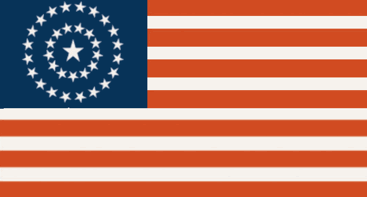
Flags without black borders
|
Lincoln Funeral Train Flags 1865
These two 35-Star flags with their black borders are examples of the Lincoln Mourning Flags flown on the locomotives that pulled the Lincoln Funeral Train. It should be understood that these special flags are only examples because the engines were switched as the train was passed from railroad to railroad. There were at least five or more different engines used to pull the train on its journey, plus more pilot locomotives that ran the tracks ahead of the actual train to make sure the tracks were clear. Each railroad used their best and most powerful engines to move the funeral train slowly from station to station and they each decorated their engines differently with locally made flags, some with black borders and some without. They were usually flown from the fenders of these locomotives.
At least 10,000 people witnessed the train's departure from Washington. The funeral train consisted of nine cars, including a baggage and hearse car. Lincoln was observed, mourned, and honored by the citizens of Washington, Maryland, Pennsylvania, New York, Ohio, Indiana, and Illinois on his way to his burial in Springfield at the Oak Ridge Cemetery. The train passed 444 communities in these 7 states.
There was such a demand for mourning flags that flag manufacturers used up all their flags in stock, adding the black borders to whatever they had. The result was Great Star designs, Concentric Circle designs, and Grand Luminary designs all being used in different places, sometimes with 33 stars, 34 stars, 35 stars, 36 stars, or even some with 37 stars, some with black borders, some without. We have dozens of different examples of these mourning flags left in various sizes and designs.
Many people in the North just wanted to have a chance to show their sorrow and flags provided a convenient medium for many.
|
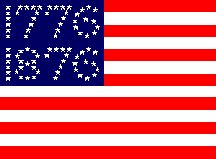
81-Star (?) US Flag
|
US Centennial Flag 1876
In 1876 Americans celebrated their nation's 100th birthday One enterprising manufacturer, ignoring the proper star count, produced this popular flag with 81 stars producing "1776-1876" with the star pattern. The actual state count by the end of 1876 should have produced a 39 stars on the flag.
|
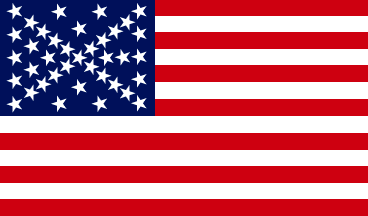
37-Star US Flag
|
The Hourglass Design 1877
The design shown here appears to have crossing diagonal lines of stars outlining the shape of the Cross of St. Andrew. Some see in this design Southern sympathies for the reconstruction south; but, if the flag is placed upright, it will also be seen that the arrangement also depicts the shape of an hourglass with two stars representing two centuries, in the process of dropping to the bottom of the glass. We could have here, therefore, perhaps a most imaginate composition celebrating the advent of the nation's First Centennial. |
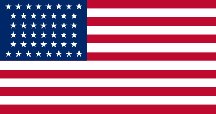
44-Star US Flag
|
Star Column Flag 1891
Hawaii lost its independence to an armed revolt led by American residents in 1893, and was annexed to the United States in 1898. I like to call this design a "Starry Column" or "Starry Pillar," complete with its starry base and capitol.
American business interests supported the overthrow of the Hawaiian government in January of 1893, whereupon they hoisted the Stars and Stripes. At first rebuffed in their attempt to secure annexation by the United States, the new leaders proclaimed Hawaii a republic in 1894 under its former national flag, but in 1898, it was officially made a U.S. territory. The former national flag of the kingdom and the republic was adopted, unchanged, by both the territory, and later, the state. |
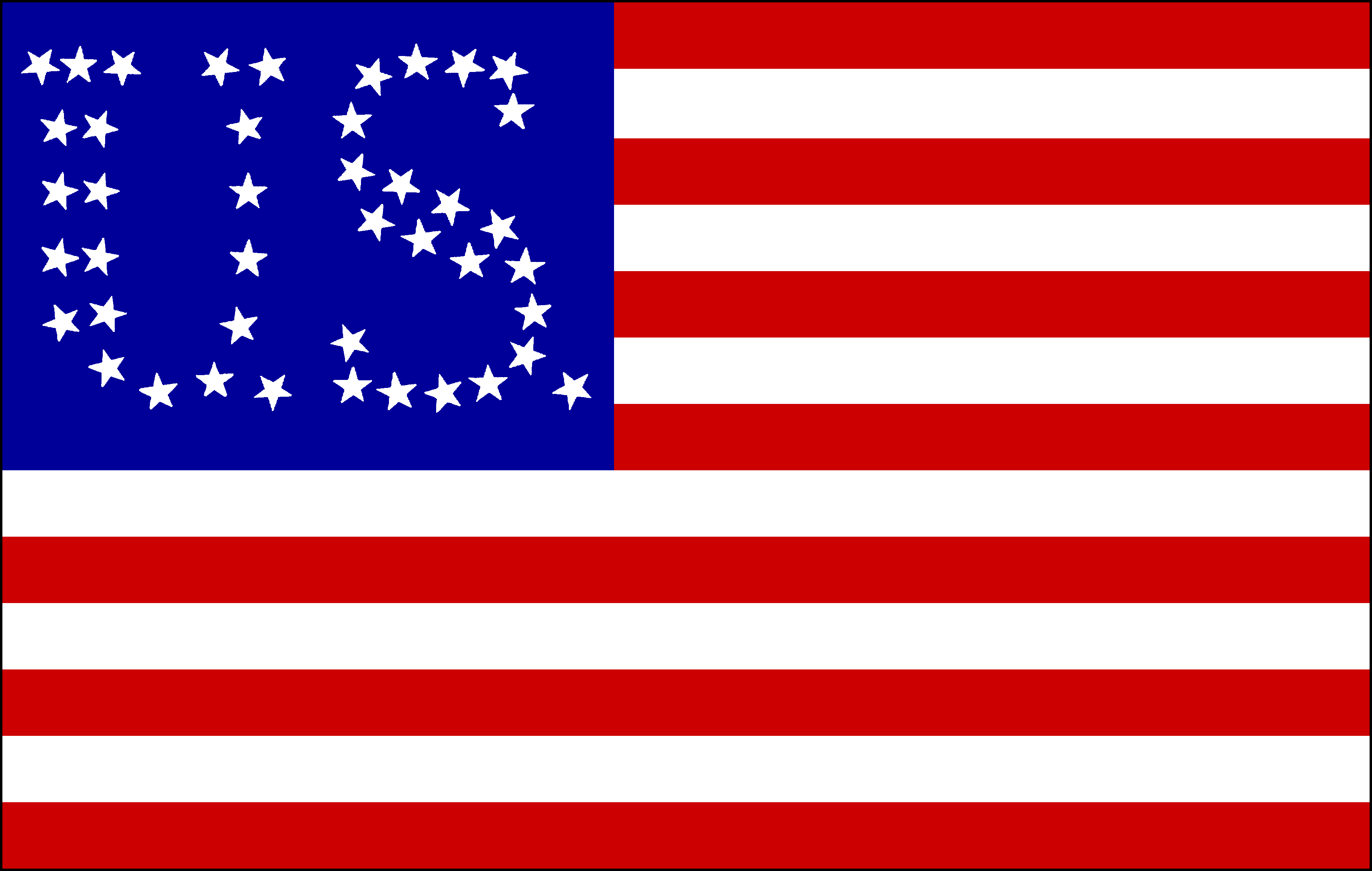
44-Star US Flag
|
Washburn Patent Flag 1891
In 1890, a man named William Washburn living in Rockland, Massachusetts, filed a patent on this interesting design for a 44-Star flag.
Other than the patent filed by Washburn there is very little known about this particular design. It is unknown if any flags using this design were ever manufactured or flown.
|
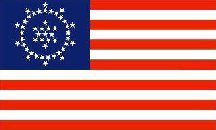
48-Star US Flag
|
The Whipple American History Flag 1917
In 1910, Wayne Whipple, a well-known author of popular books on American history, proposed a meaningful design for the star pattern of the flag. His idea was that the central 13 stars should represent the original states as on the great seal, then to surround them with a ring of 25 stars representing the states that joined the Union in the first 100 years, and then finally have a ring of ten stars representing the states that joined in the second hundred years. He called his design a "History" flag. He then challenged students who read his book to come up with their ideas for a meaningful star arrangement.
Whipple's flag design was produced by the Dettra Flag Company, which they sold as the "Whipple Peace Flag" to celebrate the end of World War I in 1917.
|
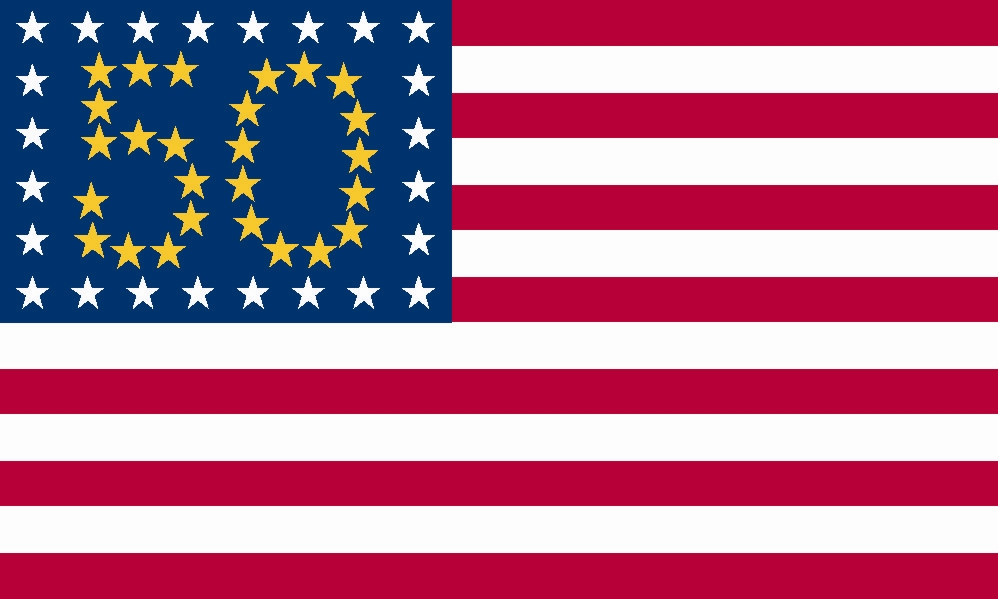
50th Anniversary Flag
|
Proposed 50th Birthday of the 50-Star Flag 2010
To celebrate the 50th Anniversary of the 50-Star US Flag (1960-2010) there have been several suggestions put forth, although Congress or the President haven't seemed interested in making anything official. It seems a shame not to celebrate the 50th birthday of our longest living flag.
Proposed designs range from the simple idea of Vexillologist Ed Mooney of making all the 50 stars gold instead of white, to this interesting multicolored version design by Vexillologist Peter Orenski mixing 26 gold stars and surrounded by 24 tradition white ones to form a number 50. |
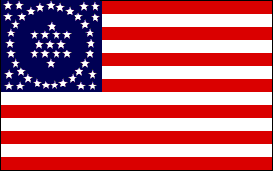
50-Star US Flag
|
50-Star History Flag
In 1979, this interesting 50-Star design was suggested by the well-known Flag Historian (Vexillologist) Dave Martucci for a new design of the United States flag.
According to Dave the symbolism is exactly the same as Wayne Whipple's history flag. In fact, he simply updated Whipple's design. Thirteen stars in shape of 6-pointed star (from Crest of US Arms) for original states, ring of 25 for states that joined the Union in first century, 3 in each corner making 12, the number of states that joined in the second century. |
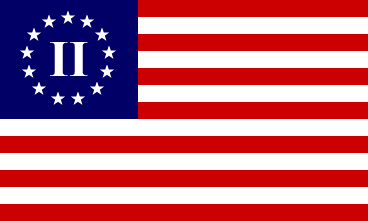
13-Star US Flag
|
Second Revolution Flag (Tea Party Flag) 2010
The Tea Party movement is an American socio-political movement that emerged in 2009 through a series of locally and nationally coordinated protests. The protests are partially in response to several Federal laws and a series of health care reform bills.
The name "Tea Party" is a reference to the Boston Tea Party of 1773 which was a protest by American colonists against various acts by the British Government. The modern Tea Party protests have invoked themes, images and slogans similar to those used during the pre-revolutionary period in American history.
|
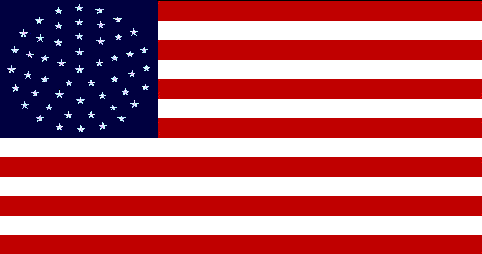
51-Star US Flag
|
Puerto Rico Statehood Movement
This is the 51-star version of the United States flag that is commonly used by supporters of the Puerto Rican Statehood Movement which advocates Puerto Rico's admission into the United States of America as the 51st state.
This interesting circular designed canton has been popular among statehood supporters on the island for years, used by the New Progressive Party of Puerto Rico whose main party platform is statehood, yet the designer of the flag is unknown.
|